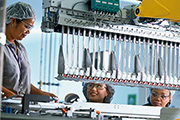Packaging plays an important role for our products in two ways. For one, it protects our products from external influences and ensures that they reach the customer undamaged. Secondly, packaging guarantees that the environment will not be negatively impacted by substances leaking out. The packaging has to remain safe throughout the product's entire life cycle – during transport, storage, usage, and disposal.
The development of suitable packaging therefore constitutes part of our product development process and contributes to product safety. One example is our Safebreak bottles, which are coated in plastic to prevent chemicals from leaking out if the glass breaks.
In addition to safety, efficient resource use also plays a crucial role. We identify potential areas of optimization in order to reduce material usage during packaging manufacture without compromising the quality and safety. This also aims to increase the percentage of materials that minimally impact the environment.
Packaging for life science tools division products
The life science tools division is currently using this approach to refine its packaging strategy. Another important aspect of the strategy is that we want to deliver our products in packaging that is easy for our customers to dispose of and that helps them reduce the impact of their own activities on the environment. We are therefore working to develop reusable packaging systems and to reduce the use of foam components. Here are a few examples:
- For shipping, glass reagent bottles are secured separately in the packages to prevent them from bumping into each other and breaking, a task we used to accomplish with EPS (expanded polystyrene) molded foam components. At the sites in Germany, the United States and India, we have launched an initiative to replace EPS packaging with molded fiber components consisting of cellulose and recycled paper. In Darmstadt, Germany, we will have replaced nearly all EPS molded foam packaging by the end of 2013, which means more than 600,000 molded foam components. For the switch to cellulose and recycled paper materials in India, we are conducting additional investigations because of the climate conditions found there. In the United States, we are furthermore looking into an alternative using corrugated cardboard.
- The majority of the cardboard boxes used to package products at US life science tools division sites are certified to the standards of the Sustainable Forestry Initiative (SFI ).
- The Lab Water business field of the life science tools division has developed new packaging for the Smart and Integral ranges of the Milli-Q lab water purification systems. Here, the molded PE (polyethylene) foam components are being replaced by corrugated cardboard; less material is utilized, thus reducing the packaging costs. In addition, the polystyrene packaging used to ship the Q-Pod and E-Pod accessories has also been replaced by molded corrugated cardboard. Thanks to the improved packaging design, we are saving 18 metric tons of corrugated cardboard per year.
- In 2012, the life science tools division conducted a life cycle assessment to investigate the material usage of reusable plastic containers versus corrugated cardboard packaging for its Millistak+®-Pod products, which are used in the production of vaccines. It showed that a reusable container reduces the amount of material used by up to 95% per individual product delivery. It furthermore revealed other possible ways to reduce the impact of distribution on the environment.
- In the 2011-2012 period, we developed a scorecard as a tool to evaluate packaging for BioMonitoring products in order to compare the environmental impact, costs and quality of various packaging designs with one another. For instance, when we developed the packaging for the EZ-StreamTM vacuum pump, a product that is used for quality testing in the beverage industry, we compared three different packaging options. We ultimately selected the packaging with the least environmental impact that met the required quality criteria and was of a comparable cost. The design was then further refined, improving the initial design with a 28% reduction in packaging weight and an 18% reduction in volume. This has enabled 30% more products per pallet. For two other BioMonitoring products, the EZ-Fit™ Manifold and the EZ-Pak® Dispenser Curve, which are also used in beverage quality testing, we have replaced the EPS foam that was formerly utilized, making the packaging now entirely recyclable.
- We have improved upon multiple aspects of the packaging for the Milliflex®Quantum sets, which are used for quality testing in pharmaceutical and biopharmaceutical production. We have cut down the packaging size, thus reducing the cardboard used by 15%, meaning that 26% more sets can fit per pallet. We have furthermore increased the percentage of recycled packaging material from 45% to 90%. These changes have also resulted in saving space for customers in tight lab settings.
Closed system for liquid crystals packaging
In South Korea, the Performance Materials division utilizes a patented system of stainless steel canisters that are filled with liquid crystal mixtures at the Poseung site and delivered to South Korean display manufacturers. Our Standard Canisters (MSCs) can be utilized directly on the production lines without decanting. The empty canisters are then sent back to us where they are cleaned under validated conditions. The MSCs are reused within a closed system over multiple years. A reusable polypropylene box serves as outer packaging. Similar systems are in use at other liquid crystal mixture production sites in Asia.

 5
5
